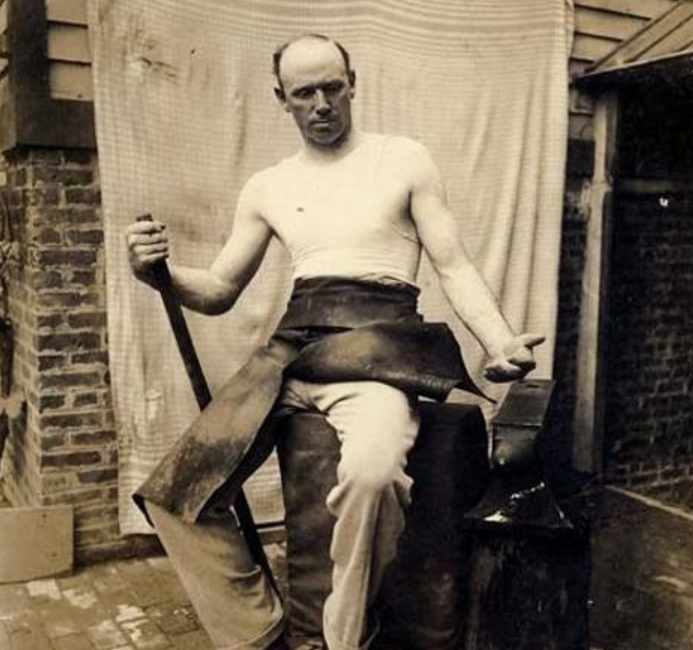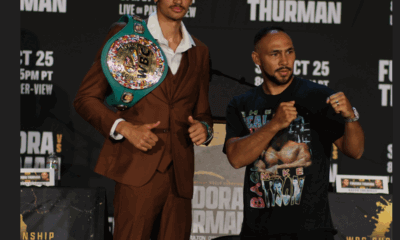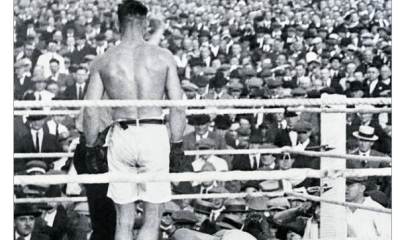Featured Articles
In Appreciation of Labor Day, a Guide to Boxers Other Occupations

In Appreciation of Labor Day, a Guide to Boxers Other Occupations
In 1894, President Grover Cleveland signed into law a bill making Labor Day a national holiday. Prior to then, Labor Day was celebrated at the local and state level in many jurisdictions.
There are few jobs that require as much dedication as that of a full-time prizefighter, but, needless to say, prizefighting alone doesn’t pay all the bills, save for a small minority. With another Labor Day upon us, let’s take this opportunity to look more closely at the jobs that well-known boxers had, both before and after and even during their careers in the squared circle.
During the bare-knuckle era in England, the occupation that spawned the most boxers was butchery. Whether working in a slaughterhouse or working with their fists, blood was a constant. In retirement, the most famous bare-knuckle boxers invariably became publicans (saloon-keepers).
As to be expected, America’s first prominent boxers, save for those that started in their mid-teens, worked in a blue-collar trade before taking up boxing. Lore has it that the original Jack Dempsey, the so-called Nonpareil, and Jack McAuliffe, the Napoleon of the Prize Ring, were co-workers in a Brooklyn cooperage. They were barrel-makers.
Big Jim Jeffries, who was considered invincible until he came out of retirement to fight Jack Johnson, worked with larger vats in his youth in Ohio. He was a boilermaker. Contemporaries Bob Fitzsimmons and Joe Choynski also worked with their hands. As a teenager in New Zealand, Fitzsimmons (pictured) was apprenticed to a blacksmith. Choynski reportedly developed the strength in his arms working as a taffy puller in a San Francisco candy factory.
Jim Jeffries was among many boxers whose former employment served as their nickname. Fireman Jim Flynn, who knocked out Jack Dempsey in their first meeting, was a fireman (i.e., coal heaver) on steam locomotives. Tony Zale had a similar job. Before finding fame in the prize ring, he tended a blast furnace in a Gary, Indiana, steel mill. Hence his nickname: Man of Steel.
Joe Glick, a leading lightweight contender during the 1920’s, didn’t work with a shovel, but with a needle and thread; he was a tailor by trade. Born and raised in Brooklyn, Glick was outfitted with one of boxing’s most outlandish nicknames. They called him the Brownsville Button Hole Maker. Others whose occupations were fused into their nicknames were Fred Apostoli, the Fighting Bell Hop, and Charlie Fusari, the Milkman. When he wasn’t training for a big fight, Fusari, who went 15 rounds in world title fights with Sugar Ray Robinson and Johnny Bratton, was up early in the morning servicing the customers on his Irvington, New Jersey milk route.
Most prizefighters were products of cities with large immigrant populations, but a few came off the farm. Carmen Basilio worked in the fields as an onion picker before boxing became his full-time gig.
A number of boxers were given nicknames that reflected the main occupation associated with the region in which they were raised. Scrolling through BoxRec, you will find several Michigan Lumberjacks, although whether they actually worked in the timber industry is open to debate. But Yvon Durelle, the Fighting Fisherman, was legit. He came from a small fishing village in New Brunswick, Canada, and as a teenager, like most of the locals, he worked on a fishing boat.
While we are on the subject of lumberjacks, Paulino Uzcudun, the Basque Woodchopper, was actually trained as a butcher. However, he competed in woodchopping tournaments which were popular in his region in Spain.
When they retired, most journeymen boxers returned to their original trade. The saddest example is that of Beau Jack who holds the record for having headlined 21 shows at Madison Square Garden. As a kid, Beau Jack shined shoes at the Augusta National Golf Club in Georgia. In retirement, he ran a shoeshine stand at the Fountainbleau Hotel in Miami Beach.
It’s well known that James J. Braddock worked as a stevedore on the New Jersey docks – when work was available, this was the Depression. Less well known is that 25 years after losing his title to Joe Louis, the Cinderella Man, as he came to be known, was discovered working as a welder on the nascent Verrazano Bridge which connects Brooklyn with Staten Island. Braddock said he didn’t need the money, he just needed to get out of the house, but if he needed the money, he would have been too proud to admit it.
In Las Vegas, many former boxers, if they never graduated beyond the preliminary ranks, can be found working as security guards. Working in some sphere of law enforcement would seem to be a natural. In fact, in the Old West, ex-prizefighters had a leg up if they ran for Sheriff. The townsfolk wanted a man who was handy with his fists.
The great light heavyweight champion Bob Foster was a police officer in Albuquerque, his hometown, during and after his pro career. Tommy Gibbons, a Hall of Famer, was elected Sheriff of Ramsey County, Minnesota, home to St. Paul, and served in that post for 24 years.
An inordinate number of ex-boxers found work in Hollywood on studio lots and appearing as extras in movies. Mushy Callahan, a former junior welterweight champion, was in high demand as a teacher of actors appearing in fight scenes. Ace Hudkins, along with several of his brothers, formed a company that leased horses and buckboards to the makers of movie and TV westerns. Hudkins, the Nebraska Wildcat, reportedly died a millionaire.
This article barely scratches the surface. We invite you to go to our Forum and plug in some of the missing pieces. And Happy Labor Day.
Check out more boxing news on video at The Boxing Channel
To comment on this story in The Fight Forum CLICK HERE
-

 Book Review4 weeks ago
Book Review4 weeks agoMark Kriegel’s New Book About Mike Tyson is a Must-Read
-

 Featured Articles2 weeks ago
Featured Articles2 weeks agoThe Hauser Report: Debunking Two Myths and Other Notes
-

 Featured Articles3 weeks ago
Featured Articles3 weeks agoMoses Itauma Continues his Rapid Rise; Steamrolls Dillian Whyte in Riyadh
-

 Featured Articles3 weeks ago
Featured Articles3 weeks agoNikita Tszyu and Australia’s Short-Lived Boxing Renaissance
-

 Featured Articles4 weeks ago
Featured Articles4 weeks agoKotari and Urakawa – Two Fatalities on the Same Card in Japan: Boxing’s Darkest Day
-

 Featured Articles3 weeks ago
Featured Articles3 weeks agoIs Moses Itauma the Next Mike Tyson?
-

 Featured Articles4 weeks ago
Featured Articles4 weeks agoRamirez and Cuello Score KOs in Libya; Fonseca Upsets Oumiha
-

 Featured Articles2 weeks ago
Featured Articles2 weeks agoBoxing Odds and Ends: Paul vs ‘Tank,’ Big Trouble for Marselles Brown and More





















